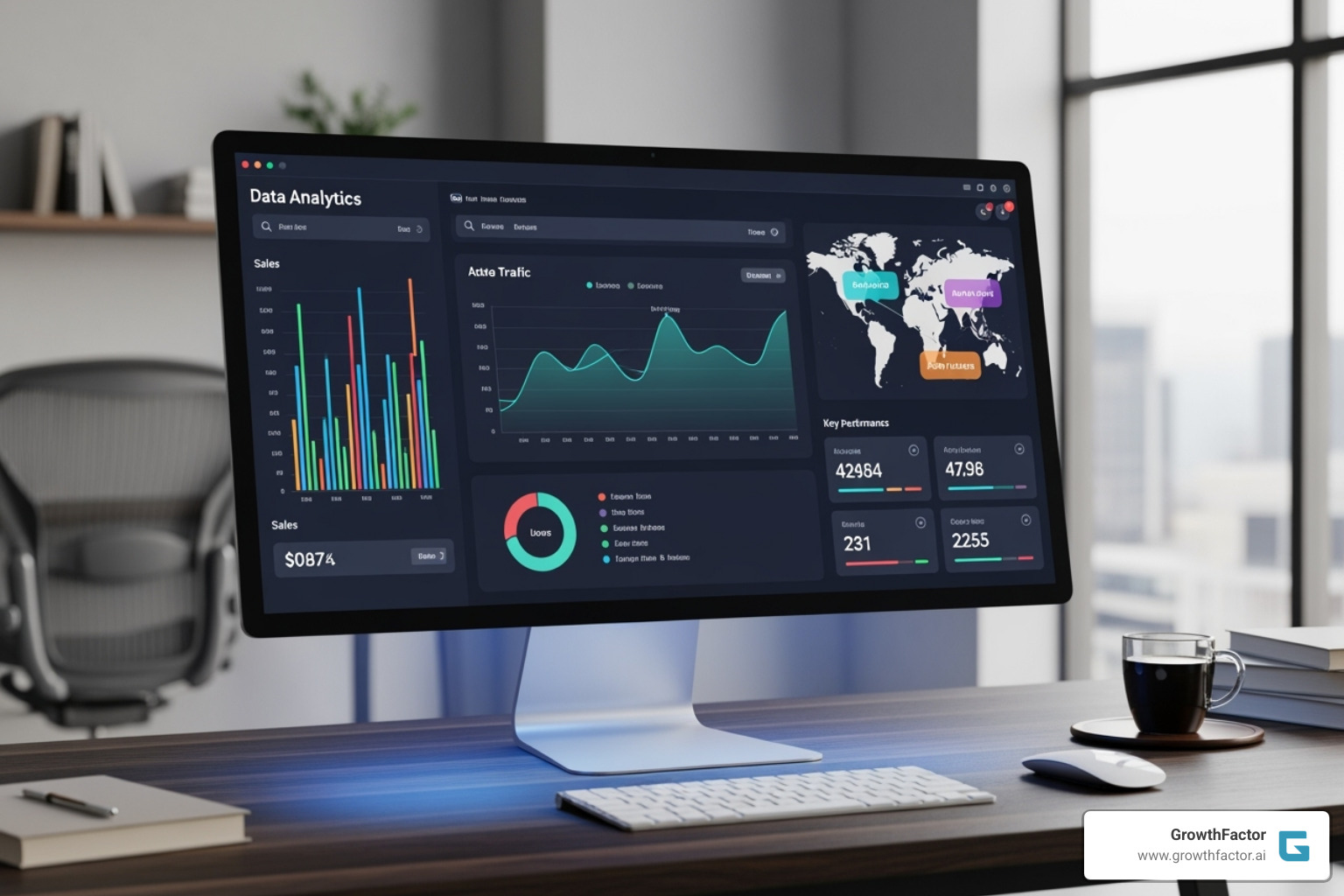In Depth Guide to Site Selection Analyst
Written by: Clyde Christian Anderson
Why Site Selection Analysts Are the Strategic Backbone of Business Expansion

A site selection analyst is a data-driven professional who evaluates potential locations for business operations. Using advanced analytics, they identify optimal sites that maximize profitability and minimize risk, guiding critical decisions that can make or break an expansion strategy.
The stakes are incredibly high. Location can determine up to 80% of a facility's operating costs, locking in expenses like wages and taxes. Without professional expertise, companies often make the wrong choice—a mistake that's usually finded too late to fix.
Modern site selection has evolved from an intuitive art into a data-driven science. Where retailers once relied on gut feelings, today's analysts leverage AI-powered platforms to evaluate hundreds of sites with unprecedented accuracy. This is crucial, as physical retail still accounts for 82% of U.S. retail sales, making location strategy a cornerstone of success. The best companies now use predictive models to forecast performance before signing a lease, turning guesswork into precision.
I'm Clyde Christian Anderson, Founder and CEO of GrowthFactor.ai. With deep experience in retail operations and investment banking, I've seen how the site selection analyst role has transformed from spreadsheet-based decisions to AI-powered strategic planning.

What is a Site Selection Analyst and Why Are They Crucial for Business Growth?
Investing hundreds of thousands of dollars in a new location hinges on one question: did you choose the right spot? This is where a site selection analyst becomes a business's strategic guardian, preventing million-dollar mistakes.
In today's competitive landscape, their role goes beyond finding empty storefronts. They are strategic masterminds who identify optimal positions for long-term growth. Since location decisions can determine up to 80% of a facility's operating costs, professional Real Estate Site Selection guidance is essential. A well-executed analysis minimizes risk, maximizes customer reach, and ensures sustainable growth.
At its core, a site selection analyst evaluates potential locations by blending the art of understanding local nuances with the science of rigorous data analysis. They become strategic advisors who translate raw data into actionable insights. As we explore in What is Site Selection, the best analysts help secure a company's future.
Their key responsibilities include:
- Market and Competitive Analysis: Diving deep into demographics, psychographics, and the competitive landscape to understand who the customers are and where competitors are located.
- Data Analysis: Using tools like Geographic Information Systems (GIS) to analyze spatial data, foot traffic patterns, visibility, and accessibility.
- Financial Modeling: Creating detailed financial projections, including property costs, sales forecasts, and ROI, while evaluating potential economic incentives.
- Due Diligence: Researching zoning laws, building codes, and environmental factors to uncover hidden risks and prevent expensive surprises.
- Reporting: Translating complex data into clear, compelling presentations that empower executives to make confident decisions.
When an analyst excels, the impact is profound. They drive profitable expansion and guard against costly failures. Their work also informs long-term planning, such as assessing real estate portfolios during mergers and acquisitions. As research from the FHWA on The Role of Transportation Investment in Private Firm Site Selection highlights, analysts must consider a complex web of factors to build the physical foundations for sustainable growth.
The Modern Site Selection Analyst: Skills, Tools, and Technology

The world of site selection has transformed dramatically. We've moved from gut feelings and basic demographic reports to sophisticated AI systems that can predict a store's performance before a lease is signed. This shift has redefined what it means to be strategic in location planning.
Essential Skills and Qualifications for Success
The modern site selection analyst needs a blend of technical and soft skills. Sharp analytical thinking and financial acumen are foundational, but they are useless without strong communication and negotiation skills to influence executive decisions. Proficiency in GIS software and data visualization is non-negotiable for turning complex data into clear, actionable stories. The rise of predictive modeling has also added a new layer, requiring analysts to use statistical methods to forecast market performance.
| Hard Skills | Soft Skills |
|---|---|
| GIS Software Proficiency | Communication |
| Financial Modeling | Negotiation |
| Data Analysis & Predictive Modeling | Critical Thinking |
| Data Visualization | Collaboration |
| Urban Planning Knowledge | Adaptability & Problem-Solving |
A Bachelor's degree in fields like finance, urban planning, or geography is typically required, but practical experience is invaluable. Continuous learning is essential to keep up with this fast-moving industry.
The Analyst's Toolkit: From Spreadsheets to AI
Today's analysts wield a sophisticated toolkit. Geographic Information Systems (GIS) are the backbone, layering data on maps to reveal spatial patterns. This is enriched by demographic data providers and foot traffic analytics, which offer granular insights into consumer behavior. Predictive modeling software uses this data to forecast sales and overall site performance with remarkable accuracy. The real game-changer, however, has been the rise of AI-powered platforms. As we explore in our guide to AI for Real Estate, these tools automate tedious tasks and provide insights that were previously impossible to achieve manually.
How AI and Data Analytics Have Revolutionized the Role
AI and advanced analytics have reimagined the site selection analyst role. The shift from manual analysis to automation frees analysts to focus on high-level strategy. Key advantages include:
- Evaluating More Sites Faster: AI platforms can assess hundreds of locations simultaneously, identifying opportunities that manual methods would miss.
- Improved Sales Forecasting: AI systems analyze countless variables to predict a location's future performance with unprecedented accuracy, turning site selection into a precise science.
- Whitespace Analysis: As detailed in our exploration of Data-Driven Site Selection, AI can identify untapped markets with high demand and low competition.
- Cannibalization Risk Assessment: AI excels at determining if a new location might steal customers from existing stores, protecting the current network.
This technological revolution has liftd the site selection analyst from a data processor to a strategic advisor, enabling proactive, predictive planning.
Career Path and Opportunities in Site Selection
The site selection field offers an exciting career journey with strong demand across many industries. Whether you're fascinated by retail or industrial logistics, there's a place for site selection analyst expertise.

Industries That Rely on Site Selection Expertise
Nearly every sector needs site selection skills, each with unique criteria:
- Retail: Quick Service Restaurants (QSRs) and big-box stores focus on visibility, access, and demographic alignment. Our Retail Location Analysis approach is critical here, as physical retail still dominates sales.
- Industrial: Manufacturing and logistics prioritize transportation networks (highways, ports), labor availability, and infrastructure capacity.
- Commercial Real Estate: Offices and mixed-use developments are driven by talent attraction, public transit, and quality-of-life amenities.
- Healthcare: Clinics and hospitals require analysis of patient populations, community accessibility, and infrastructure.
- Service-Based Businesses: Banks, fitness centers, and call centers each have specific drivers, from foot traffic to labor pool characteristics.
Typical Career Trajectory and Advancement
The career path offers clear progression. Professionals often start as Junior Analysts, supporting senior team members for 1-2 years. With 3-4 years of experience, they can advance to a Site Selection Analyst or Senior Analyst role, leading projects and making strategic recommendations. Senior leadership opportunities include Site Selection Manager, Director of Real Estate, or VP of Location Strategy. Many seasoned professionals also move into consulting. The job market is strong, with platforms like LinkedIn showing over 5,000 site selection jobs in the U.S.
Advice for Aspiring Site Selection Analysts
Breaking into the field requires strategic preparation:
- Education: A Bachelor's degree in finance, urban planning, real estate, or geography is standard.
- Experience: Seek internships with real estate firms, market research companies, or corporate real estate departments to gain practical skills.
- Technology: Master GIS software and become familiar with data analytics tools and AI platforms. This is non-negotiable.
- Networking: Connect with professionals through industry associations like CoreNet Global and on LinkedIn.
- Continuous Learning: Stay current with emerging technologies and trends. For more career details, explore resources like Real Estate Site Analyst career information.
Overcoming the Biggest Challenges in Site Selection Analysis
Even with advanced tools, a site selection analyst faces significant challenges. Understanding and preparing for these obstacles is key to success.
- Data Limitations: Gaps in demographic data or competitive intelligence are common. The best approach is to cross-reference multiple data sources to build a more reliable picture.
- Analysis Paralysis: With access to more data than ever, it's easy to get stuck. A clear evaluation framework and firm deadlines are essential to maintain momentum.
- Securing Stakeholder Buy-in: Site decisions affect many departments, each with its own opinion. Involving key stakeholders early and using clear, data-driven presentations helps build consensus.
- Ignoring Market Shifts: Relying on outdated data is a costly mistake. Real-time data and trend analysis are needed to make decisions based on future opportunities, not past realities.
- Failing to Prioritize Criteria: A convenience store's needs differ from a manufacturing plant's. Analysis must be custom by properly weighting criteria for each specific business model.
Modern AI-powered platforms help solve many of these challenges by automating data collection, standardizing evaluations, and providing real-time insights, making the site selection analyst role more efficient and strategic.
Frequently Asked Questions about the Site Selection Analyst Role
What is the average salary for a site selection analyst?
Compensation for a site selection analyst is competitive, reflecting the role's strategic importance. Salary varies based on factors like experience level, geographic location (with major metro areas paying more), industry sector, and employer size. Most positions include comprehensive benefits and performance bonuses, making it a well-compensated career path.
How long does a typical site selection process take?
The timeline varies dramatically, from 3-6 months for a simple retail location to 12-18 months or more for a complex industrial facility. Factors like the number of sites, due diligence requirements, and stakeholder decision-making speed influence the duration. However, technology is changing the game. Traditional manual analysis is often too slow for today's market. AI-powered platforms can reduce time spent on site selection by up to 80%, allowing teams to evaluate hundreds of sites simultaneously and secure prime locations before competitors can react.
Is a site selection analyst the same as a real estate broker?
No, these are distinct roles. A site selection analyst is a strategic advisor focused on feasibility and optimization. They use data to determine where a company should locate for maximum long-term success. They are typically salaried or fee-based, ensuring their recommendations are objective. A real estate broker is a transaction-focused professional who facilitates the buying or leasing of property. They are typically commission-based, meaning their primary incentive is to close a deal. The best outcomes occur when they collaborate: the analyst provides the strategic intelligence, and the broker executes the transaction.
Conclusion: The Future of Site Selection is Intelligent and Strategic
The role of the site selection analyst has evolved from educated guesswork to a sophisticated science powered by AI and advanced data analytics. We've moved from months spent in "spreadsheet purgatory" to a world where AI can evaluate hundreds of sites in a fraction of the time. This isn't just an efficiency gain; it's a strategic revolution.
The modern site selection analyst now represents the perfect blend of human insight and technological power. While AI handles the heavy lifting of data processing, the analyst provides irreplaceable strategic thinking and market intuition. This synergy creates a level of accuracy and speed that was previously impossible.
The impact on business growth is profound. The analyst is no longer just finding empty buildings; they are architecting a company's physical footprint for long-term success. At GrowthFactor, our AI-powered platform is designed to amplify this expertise, not replace it. By automating time-consuming tasks, we free analysts to focus on what they do best: turning complex data into winning strategies.
The future belongs to businesses that accept this blend of rigorous analysis and innovative technology. Empower your team with GrowthFactor's AI platform for site selection and find how the right technology can make every location decision your smartest one yet.
Citations
The human algorithm
Request Your demo
Schedule meeting
Or submit your information below and we'll be in touch to schedule.



